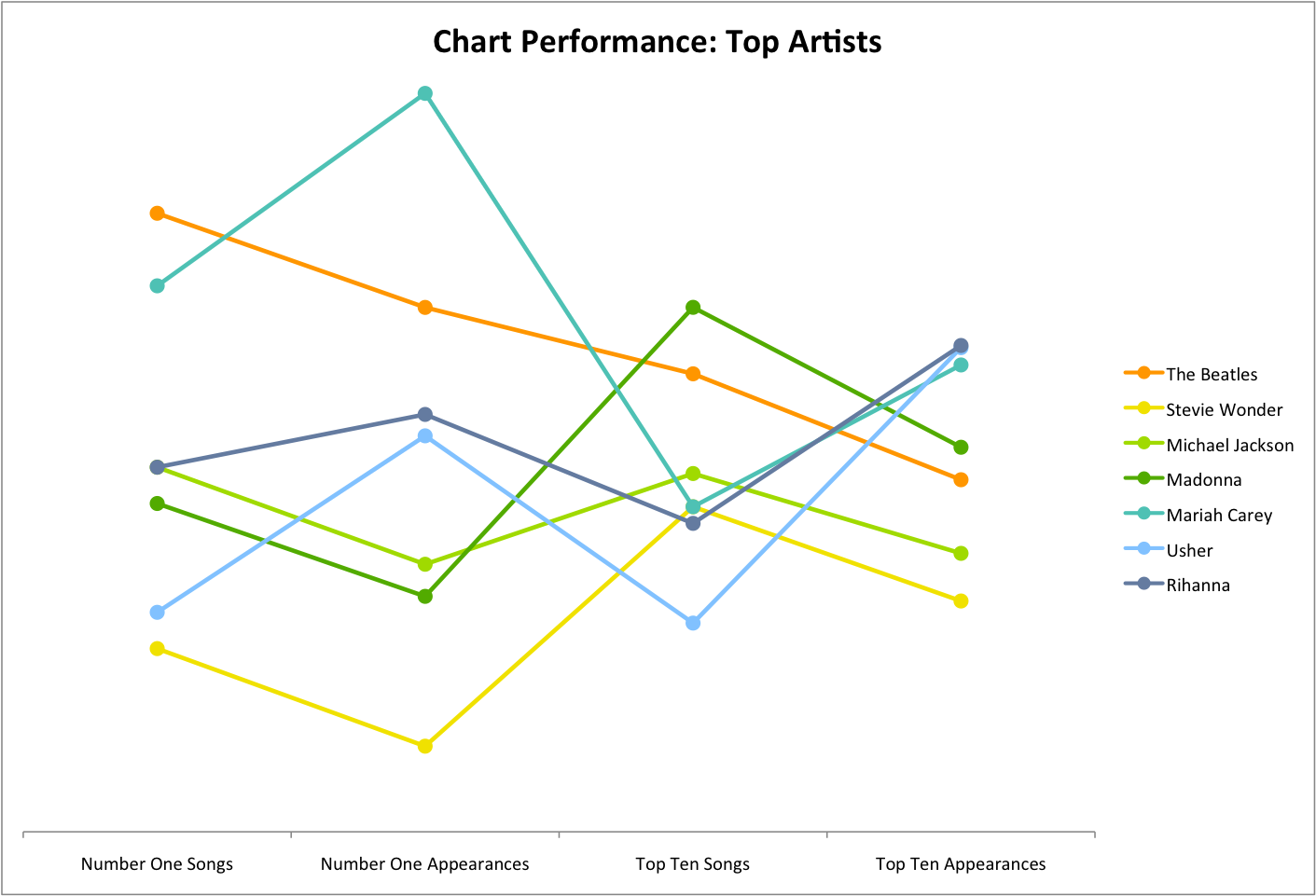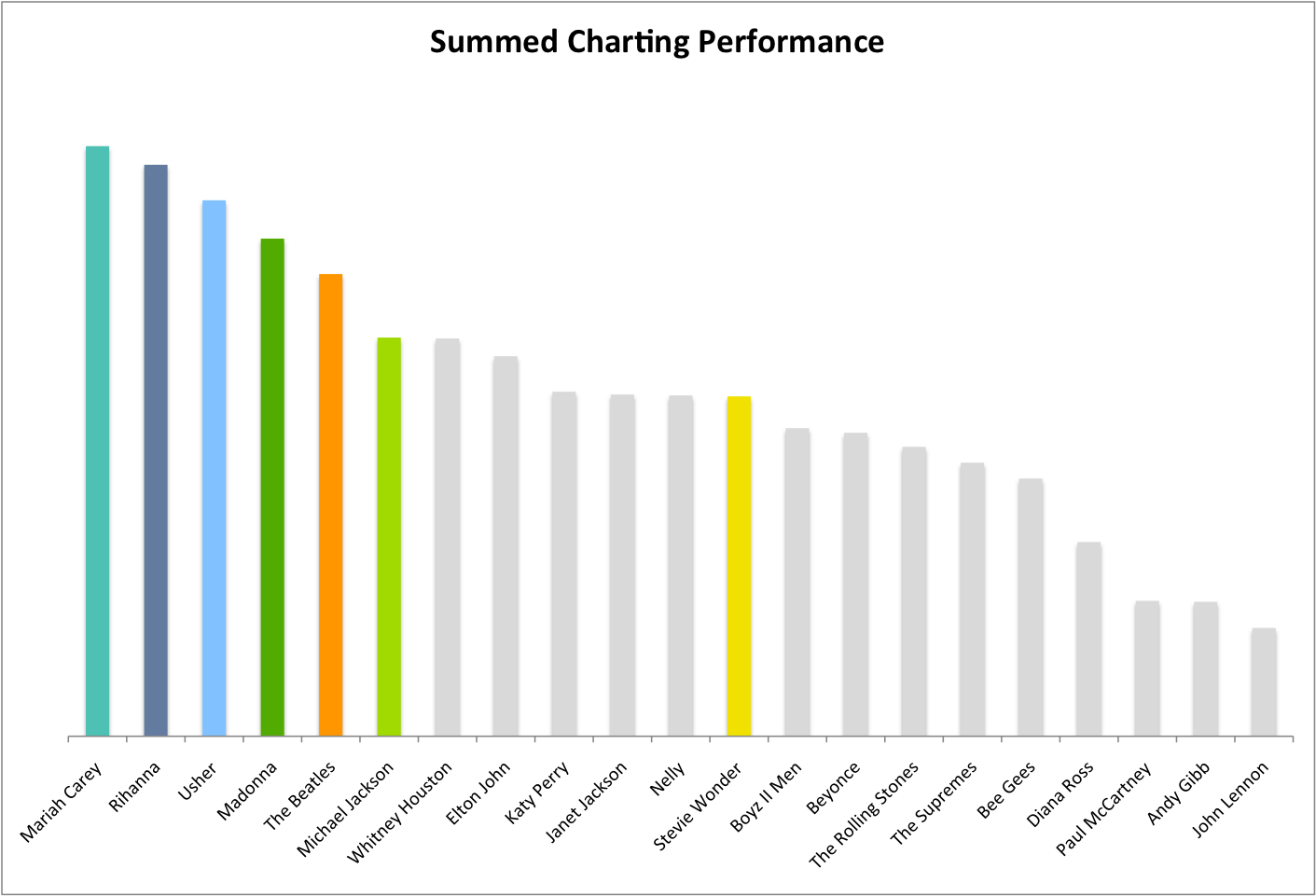Overview
One of the first questions about pop music that occurred to me was: is Michael Jackson truly the king of pop, as he was often called? If not Michael, who is the true king1 of pop? At an intuitive level, it seemed to me that being the king broke down to two main factors: the king should have the most hit songs of all time, and the king should have been a dominant presence on the charts for many years, such that you could barely listen to pop music without hearing one or another of his or her songs.
Counting the Hits
My main source of data for tracking hits over the years is weekly top ten lists for 1964-2013. I considered several possible metrics for number of hits for an artist2:
– Number One Songs: the number of distinct songs by the artist to hit number one for at least one week
– Number One Appearances: the total number of song appearances at number one.
– Top Ten Songs: the number of distinct songs that ever entered the top ten.
– Top Ten Appearances: the total number of song appearances in the top ten.
If an artist has a song appear in the top ten for 6 weeks, he will get credit for 1 top ten song and 6 top ten appearances. If that song spends 2 weeks at number one, he will also get a number one credit and 2 number one appearances.
While it’s not clear that any one of these is necessarily the one best metric, it seemed to me that any viable king would have to excel at at least one. Therefore, rather than try to a priori combine these metrics into a single weighted score of some kind, I decided to just explore how various artists look under all these metrics to see if there was an obvious winner. My first step was to compute the above metrics for each of the approximately 2000 distinct artists I found in the weekly top ten data. Under the assumption that no one could be the king of pop without scoring well on at least one metric, I then created a list of candidates composed of all of those who made the top ten in at least one metric: Bee Gees, Beyonce, Boyz II Men, Elton John, Janet Jackson, Katy Perry, Madonna, Mariah Carey, Michael Jackson, Nelly, Rihanna, Stevie Wonder, The Beatles, The Rolling Stones, The Supremes, Usher, and Katy Perry. Because I also wanted to consider crediting solo artists with their band work (for example, what boost does Michael Jackson get if we count his work in the Jackson 5?), I added several solo artists whose bands had scored well: Paul McCartney, John Lennon, Diana Ross, Janet Jackson, and Andy Gibb. The total count of candidates came to 22.
While I was able to automatically extract some structure from artist names (for example, “Eminem featuring Rihanna” is parsed to give credit to Eminem and to Rihanna), there were some errors (for example “Eminem & Rihanna” was not parsed correctly due to the risk of incorrectly parsing “Kool & The Gang”). Therefore, I carefully combed the data for missed appearances by these twenty-two top candidates and recomputed their metrics. Some of the metrics are at very different scales (Top Ten Appearances is significantly larger than Number One Songs), so to make them easier to compare at a glance I recomputed each as a percentage of the total for all candidates and charted them. This chart shows normalized performance on each of our four metrics for the top candidates.

As no one stands out as a clear winner, I next eliminated every artist who is exceeded in every metric by another. For example, Whitney Houston scores fairly well, but is behind Madonna in every metric; surely, she cannot be the king of pop. This left me with seven candidates: The Beatles, Stevie Wonder, Michael Jackson, Madonna, Mariah Carey, Usher, and Rihanna. Here we view their normalize performance metrics alone. (Raw metrics are available as well, for the curious.)

There is no obvious winner, but the king is probably one of The Beatles, Madonna, Mariah Carey, or Rihanna, each the leader in one metric. Before moving on to dominance over time, I decided to explore a summed weighted metric to see if that shed any more light. First, I simply summed the five metrics to produce a score for each artist.

Mariah Carey ends up on top, with most of the other candidates right behind her. Of course, these metrics shouldn’t all necessarily get equal weight. Our four chart metrics vary on two dimensions: number ones vs. top tens, and songs vs. appearances. Using weights for these two oppositions, I explored the space of results under various weighting schemes. I found that only two candidates ever top Mariah Carey in total score: Rihanna (if we extremely discount number ones and emphasize appearances over songs) and Madonna (if we extremely discount number ones and emphasize songs over appearances). Throughout most of the reasonable parameter space, Mariah Carey ends up with the highest score. If we were going on these metrics alone, Mariah Carey would be my pick for the king of pop.
Chart Dominance Over Time
My second criterion for choosing a king of pop was an extended period of chart dominance or cultural ubiquity. I briefly considered a sort of density score — how much of the artist’s career he or she spent in the top ten — but that obviously penalizes artists with long careers of declining relevance in favor of those with a short burst of domination, which didn’t seem the right direction.
Instead of density, we might look at years during which the artist is one of the top artists, measured by chart appearances for that year. We can create multiple metrics by looking at years as the top artist, in the top 5, the top 10, and so on. This chart shows the number of years each of our artists has been among the top artists.

We can see that the Beatles were often at the top of the charts — 3 years as the top artist, and 7 in the top five. However, their career wasn’t long enough for them to be in the top 100 more than 10 years. Madonna, on the other hand, has been among the top 100 artists for 20 of the 30 years since she first appeared in the charts. Stevie Wonder and Mariah Carey have shown similar staying power.
We can visualize this data over time as well. The chart below shows the top artist (of our 7 candidates) for each year. We can see periods of dominance for The Beatles, Madonna, Mariah Carey, and Rihanna, along with more fractured periods. None of our 7 candidates charted in 1978 or 1981.

This chart adds additional rankings for each year, so we can see, for example, Stevie Wonder’s presence during the 70s and Madonna’s during the 90s.

If we believe the king should have a long period of chart dominance or at least cultural relevance, the best candidates seem to be Stevie Wonder, Madonna, and Mariah Carey. I would give the edge to Madonna; she has a decade of dominance, another of strong relevance, and a third of occasional appearances. Only Mariah really comes close, with her own decade of dominance and many additional relevant years.
Who is the King of Pop?
On raw metrics, Mariah Carey was my top pick. On dominance over time, Madonna. Each is strong in both categories. However, Mariah Carey’s lock on the metrics and comparable career over time make her the true king of pop. Clearly, Madonna was once the king and was eventually succeeded by Mariah Carey, who will herself almost certainly be succeeded by Rihanna, if Rihanna continues her current career trajectory. According to Wikipedia, Michael Jackson was first referred to as the king in 1984, after “Thriller” swept the Grammys. He was the king of pop at that moment and has remained a cultural icon ever since; however, when we look at chart performance, he was eclipsed by Madonna and then others.
Posts on 50 Years of Pop Songs
– What is the biggest one-hit wonder of all time?
Footnotes
1 I’m using “king” because of the Michael Jackson nickname, but of course the king may be a woman. I considered going with “monarch” but “king” just sounds better. I’m also allowing the king(s) to be a band, if it turns out that way.
2 An artist gets credit for any solo song, duet, or with/featuring credit. A band is credited with every song by the band or any with/featuring credit. I explored giving solo artists credit for work they did with a band but ended up deciding not to do so; see the digressions.